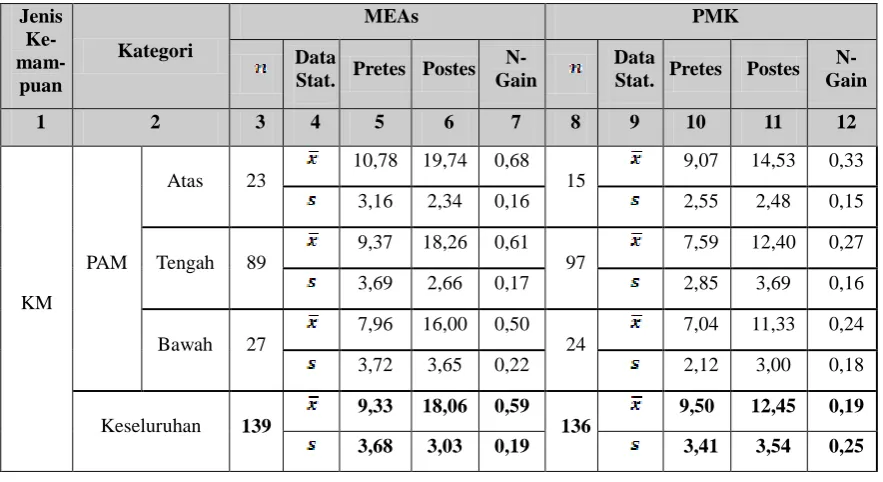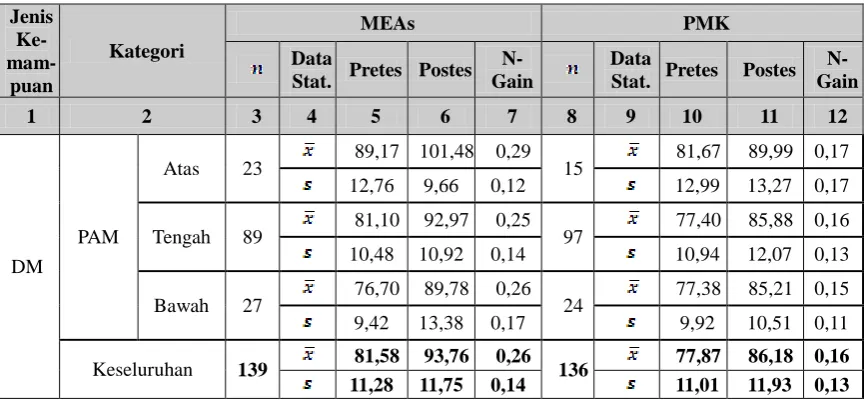ME-41
IMPROVING SENIOR HIG
H SCHOOL STUDENT’S M
ATHEMATICAL
COMMUNICATION ABILITIES AND MATHEMATICAL DISPOSITION BY
USING MODEL-ELICITING ACTIVITIES
Adi Asmara
Mathematics Program of FKIP UMB email: [email protected]
Abstract
This study is a pretest-posttest quasi experimental control group design conducted to investigate the role of model-eliciting activities approach, school cluster, and prior mathematics ability on student’s mathematical communication and mathematical disposition. The study involved 74 tenth grade students from senior high school in Bengkulu. The instrumen were a mathematical communication test , and a mathematical disposition scale. The data were analyzed by using two paths Annova, Scheffe test, and t-test. The study found that model-eliciting activities approach have influence toward attaining and gaining mathematical communication and disposition.
Keywords: model-eliciting activities approach, mathematical communication, mathematical disposition.
INTRODUCTION
Mathematical communication abilities and disposition are essential abilities and affective aspect should be possessed by senior high school students. One of the general objectives of mathematics learning which is formulated by National Council of Teachers of Mathematics (NCTM, 2000) is learning to communication (mathematical communication). Mathematics communication need to be developed in students, Baroody (1993) stated that learning must help students in communicating mathematics idea through five communication aspects such as representing, listening, reading, discussing, and writing. Then, he also stated that at least there are two important reasons about why communication in mathematics learning needs to be developed in students. First, mathematics as language, it means mathematics not only a tool to aid thinking, tool to find pattern, solving problems or drawing
conclusion, but mathematics also is “an invaluable tool for communicating a variety of ideas
clearly, precisely, and succinctly. Second, mathematics learning as social activity: it means that as social activity in mathematics learning, also as means of interaction among students, and also
communication between teacher and students. It is also an important part in “nurturing children’s mathematical potential”.
Mathematics communications are: (1) main strength for students in formulating concept and mathematics strategy; (2) key of success for students towards approach and completion in exploration and mathematics investigation; (3) means for students to communicate with their friends in obtaining information, sharing and finding ideas, brainstorming, valuing and exacerbating ideas to convince others.
Besides cognitive aspect, affective aspect is also important in mathematics learning.
Affective aspect is also taking part in students’ success in learning mathematics; such affective aspect is mathematical disposition. The role of affective aspect and cognitive aspect in learning mathematics. Both aspects simultaneously give impact in students’ learning achievement.
Technology development also give impact in enriching learning sources that can be accessed, it will support their learning for students who do self-regulated learning. Students who are given with MEAs learning and refutation textare assumed have more mathematical disposition than students who are given with conventional learning.
Mathematical Disposition
Mathematical disposition was a very important target because it will apparent in every aspects of their mathematical activities. This research showed that there are positive correlation between mathematical disposition and mathematics achievement. This result was in mutual accord with the assumption that positive mathematical beliefs, attitudes, and feelings will lead to increased mathematical achievement. Teachers must help students develop perseverance and broader their view of mathematics. This will increase student mathematical disposition, and because of the positive correlation with mathematics achievement, the mathematics achievement will be increased as well. Hopefully the level of Indonesian student mathematics achievement will be increased as well in the next TIMMS survey. Though the SMA students realize the importance of mathematics, their social activities takes much of their time. This situation was in mutual accord with Chandler and Mahar findings that online communities affect adolescent much because it offered them richer and more satisfying lives than they had in real time.
Mathematical Communication
Mathematics is the language of symbols in which every person who learns mathematics required to have the ability to communicate using the language of symbols. Mathematical communication skills will make a person could use mathematics for its own sake as well as others, so that will increase positive attitudes towards mathematics both from within oneself and others. Sumarmo (2000) argued that mathematics as a language of symbols implies that mathematics is universal and can be understood by anyone anytime and anywhere. Each symbol has a clear meaning, and mutually agreed by everyone. According Sumarmo (2000), the development of language and symbols in mathematics aims to communicate the mathematics so that students can:
a. reflect and explain the students' thinking about mathematical ideas and relationships; b. formulate mathematical definitions and generalizations through the method of the
invention;
c. express mathematical ideas orally and in writing; d. read the discourse of mathematics with understanding;
e. clarify and expand the question to the mathematics he had studied;
f. appreciate the beauty and power of mathematical notation and its role in the development of mathematical ideas.
Mathematical communication support other mathematical skills, such as problem-solving ability. With good communication skills then the problem will sooner be represented correctly and it will be supported to resolve the problem. Communication skills is a prerequisite for solving mathematical problems, that is if students can not communicate properly interpret mathematical problems and concepts it can not resolve the problem properly.
ME-43
(1) Representing. Making a representation means making other forms of idea or problem, suppose a table form represented in diagram form or otherwise. Representations can help students to explain concepts or ideas and enables them to get problem-solving strategies. Moreover, it can increase flexibility in answering math problems. But starting from the NCTM 2000, the ability of mathematical representations is an ability separate and apart from the mathematical communication skills.
(2) Listening. Aspects of listening is one very important aspect in the discussion. Ability in listening to the topics being discussed will affect students' ability to give an opinion or comment. Students should listen carefully when there are questions and comments from friends.
(3) Reading. The process of reading is a complex activity, because in it there are aspects of remembering, understanding, comparing, analyzing, and organizing what is contained in the passage. By reading, it becomes a mathematical scientific community in which one member with another member of give and take mathematical ideas.
(4) Discussion. In discussions students can express and reflect her thoughts regarding the content being studied. Students can also ask for things that are unknown or are still hesitant.
(5) Writing. Writing is an activity undertaken by the conscious mind to reveal and reflect, as outlined in the paper media, computer or other media. Writing is a useful tool of thinking as students gain experience mathematics as a creative activity. By writing, students transfer its knowledge into written form.
Model-Eliciting Activities (MEAs)
One of the lessons that requires the interaction of students in the group is learning Model-Eliciting Activities (MEAs). MEAs learning is learning based on real life situations of students, working in small groups, and presents a mathematical model as a solution. MEAs in learning, students worked ingroup activities to allow for a higher educational interaction between students and between students and teachers. Social experience is expected to present a model of efficacy, efficacy assessment information as well as verification of self-efficacy so that development can occur. It is based on Bandura's (Wilson & Janes, 2008) which states that the social model is one of the method that it can be used to strengthen self-efficacy. In addition, the presentation of a mathematical model as a solution in MEAs learning is one of the forming of external communication that can be done by students. Working in groups can also provide wider opportunities for students to communicate ideas / mathematical ideas into a form of communication so that the students' understanding of the concept becomes better.
This is in line with the reality principle MEAs learning which states that the scenarios presented in the MEAs should be realistic and could happen in the lives of students. The fact is an important component in MEAs. Creating a realistic scenario (closely related to the student) it can include abstract mathematical concepts and enhance students' interest will be a problem. Problem of shaped word-problem was requiring the interpretation and representation in mathematical form. The process of interpretation and representation is important because it provides an opportunity to makeconnections between related mathematical ideas.
RESEARCH METHOD
achievement and gain on mathematical communication abilities and disposition, to analyze the different between learning approach and prior mathematics ability on mathematical communication abilities.
Design of the study was as follow O X O
O O
Note : O : pretest and postest of mathematical communication X : Model-Eliciting Activities (MEAs)
Subjects of this study were 64 eleventh grade students from senior high schools in Bengkulu, and the instruments were a set of mathematical communication test, and a set of mathematical disposition scale. The communication test each of them consists of two parts and each part consists of 8 items and disposition scale was modified from Sumarmo (2002).
Before experiment is carried out, the subjects was classified into three level based on prior mathematics knowlege. The test consisted of 20 items of essay form adopted from National Examination of 2004-2009. The classification is determined by using rules as follow: high level (more than 70% of ideal score), medium level (between 50% -69% of ideal score) and low level (less 50% of ideal score). The data were analized by using one and two path ANOVA, Scheffe test, t-test.
RESULT AND DISCUSSION
Results of descriptive analysis of students' mathematical communication, learning group, and prior knowledge level are presented in Table 1.
Table 1
ME-45
Based on Table 1. In general , it can be concluded that the average and the enhancement (N-gain) of students' MEAs higher than under CL. Based on the prior knowledge factors, average and enhancement (N-gain) both the students' MEAs of high and middle PAM higher than under PMK. Moreover, the average and enhancement of MEAs of high level better than middle level students who under PMK. Thus, it can be concluded that the average and enhancement of students' MEAs of high -level better than the middle level students.
Results of descriptive analysis of students' mathematicaldisposition, learning group, and prior knowledge level are presented in Table 2.
Table 2
Students' Mathematical Disposition, Learning Group , and Prior Knowledge Jenis
Based on Table 1. In general , it can be concluded that the average and the enhancement (N-gain) of students' MEAs higher than under CL. Based on the prior knowledge factors, average and enhancement (N-gain) both the students' MEAs of high and middle PAM higher than under PMK. Moreover, the average and enhancement of MEAs of high level better than middle level students who under PMK. Thus, it can be concluded that the average and enhancement of students' MEAs of high -level better than the middle level students.
CONCLUSION AND SUGGESTION
Based on the results obtained following conclusions: (1) The quality of students' mathematical communication ability who under model-eliciting activities is better than those who under the conventional learning at each level (upper, middle, and lower). (2) The enhancement (N-gain) of students' mathematical disposition who under model eliciting activities higher than those who under conventional learning at each level (upper, middle, and lower.
REFERENCES
Baroody, A.J.(1993).Problem Solving, Reasoning, And Communicating, K-8 Helping Children Think Mathematically.New York: Macmillan Publishing Company.
NCTM. (2000). Defining Problem Solving. [Online]. Tersedia: http://www. Learner. org/channel/courses/teachingmath/gradesk 2/session 03/sectio 03 a.html. [3 September 2007].
Sumarmo, U. (2000). Proses Belajar dan Pemahaman Materi Kuliah. Makalah disampaikan pada Lokakarya Peran Pedagogi dalam Peningkatan Proses Pembelajaran TPB ITB di Bandung pada tanggal 4 Desember 2000.

